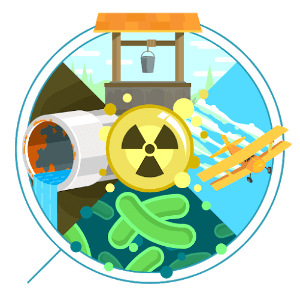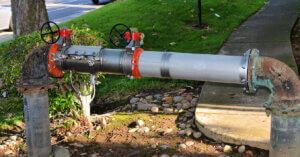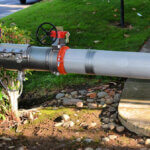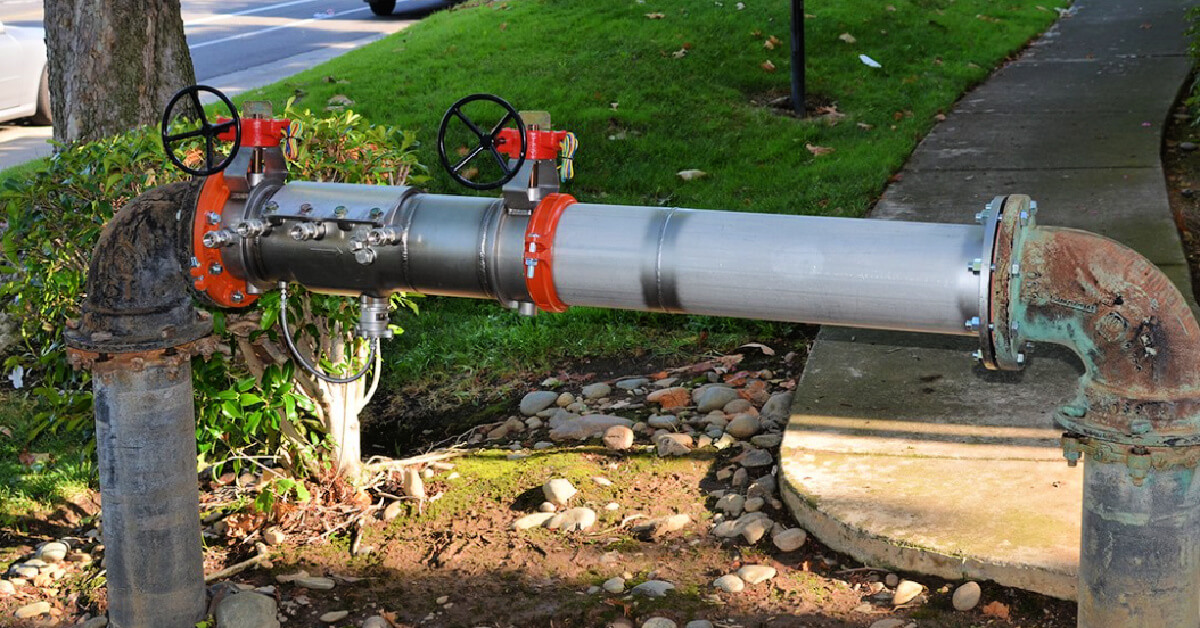Bacteria in Groundwater Sources and Types
Common Bacteria in Well Water: Groundwater can harbor various bacteria, including coliform bacteria such as E. coli. These organisms are indicative of fecal contamination and potential health risks.
Groundwater Sources of Contamination: Bacterial contamination of groundwater is a serious issue that can come from many different sources.
- Agricultural Runoff: Fertilizers, pesticides, and farm livestock waste can seep into groundwater.
- Septic System Leakage: Malfunctioning or improperly maintained septic tanks can leak, contaminating nearby water wells.
- Industrial Pollution: Discharge from manufacturing facilities, mines, or other industrial activities can contaminate groundwater sources.
- Landfills and Waste Dumps: Chemicals and other pollutants from landfills can leach into the groundwater.
- Urban Runoff: Pollutants from roads, parking lots, and urban areas, like oils and heavy metals, can infiltrate well water.
- Forestry Activities: Chemicals used in forestry, such as herbicides, can contaminate water sources.
- Natural Soil Contaminants: Certain soils may naturally contain harmful substances like arsenic or radon that can leach into groundwater.
- Road De-icing Chemicals: Salts and other chemicals used for winter de-icing roads can run into groundwater.
- Oil and Gas Drilling: Accidental spills or leaks from oil and gas drilling operations can lead to groundwater contamination.
- Storm Water Runoff: Heavy rainfall or melting snow can carry various pollutants into groundwater systems.
- Faulty Well Construction or Poor Location: Improperly constructed or poorly located wells can be more susceptible to contamination.
- Overuse of Groundwater: Excessive groundwater pumping can lead to saltwater intrusion and contamination.
- Abandoned Wells: Unused or abandoned wells can serve as direct channels for surface contaminants to enter the aquifer.
- Chemical Storage and Handling Areas: Improper storage or handling of chemicals, such as pesticides or cleaning agents, can result in accidental spills.
Climate Change Impacts: Changing weather patterns and increased flooding can alter groundwater flow and contamination patterns.
Identifying and addressing these various contamination sources is crucial to ensuring water supply safety.
Health Implications: Bacteria in Well Water
Risks: Drinking water contaminated with bacteria can cause gastrointestinal diseases, presenting a risk of infection and long-term health problems.
Vulnerable Populations: Certain groups, such as the young, elderly, and immunocompromised individuals, are more susceptible to the negative effects of contaminated well water.

Prevention of Water Well Contamination
Maintaining water wells in Fraser Valley is crucial to preventing bacterial contamination. Strict adherence to construction, upkeep, and safety protocols is necessary.
How to Treat Coliform Bacteria in Well Water
Best Water Treatment for Bacteria in Well Water: There are various methods to treat contaminated water in wells, such as UV sterilization, ozonating, and chlorination, that can prevent health risks. Shocking your Fraser Valley water well may be helpful in the short term but does not protect a water supply from becoming re-contaminated. For peace of mind well water should be sterilized by a more permanent method as raw water is vulnerable regardless of the depth of the well.
Private Water Well Guidelines British Columbia
A lack of strict regulations characterizes British Columbia’s private well framework, in contrast to the province’s public water systems. Private wells lack government oversight and are not required to comply with specific water quality standards.
This lack of private water well regulations in British Columbia means property owners are responsible for ensuring their water’s safety and quality.
To assist property owners in the Fraser Valley with private water wells, various health and environmental agencies provide guidelines and suggestions.
Although not legally binding, the guidelines offer valuable advice on best practices for maintaining and testing well water quality. They frequently refer to the Canadian Drinking Water Guidelines, recommending that private well owners follow these standards voluntarily to protect their health and that of those who consume the water.
Private water well owners in the Fraser Valley are responsible for maintaining water quality and safety by following recommended practices for self-regulation.
Fraser Valley Water Testing Lab offers local water testing and lab services for rural property owners with private water systems. The service area includes a wide range of locations, such as Abbotsford, Chilliwack, Yarrow, Langley, Mission, and Maple Ridge.Water Testing Near Me in the Fraser Valley
Support for Water Wells in the Fraser Valley
Available Resources: Owners of private wells on the mainland of British Columbia can seek help from Fraser Health Private Well Owners and Environmental agencies. These organizations can provide valuable information and support for water well management and contamination concerns.
Community Awareness: Educating the Fraser Valley communities about safe water practices is key to ensuring the safety of private water wells. This kind of communal knowledge-sharing is crucial to maintaining good water quality.
Climate Change and Environmental Impacts
Effects on Water Quality: Environmental and climate changes pose potential risks to groundwater quality, increasing the likelihood of contamination.
Sustainable Practices: Sustainable water usage and mindful environmental management are key to conserving water well integrity in the face of environmental changes.
British Columbia Wild Fires and Water Wells: In the aftermath of a forest or wildfire in British Columbia, managing a water well involves inspecting for damage, testing and cleaning the water system for contaminants, and seeking professional advice for water well repair and maintenance.
After a wildfire, It’s crucial to sanitize the well, particularly if microbial contamination is suspected. Ongoing maintenance and adherence to local and provincial guidelines are essential for ensuring water safety and water well functionality post-forest fires.
Assess Water Wells After Flooding Events
Ensuring the safety of your Fraser Valley water well, particularly after a flooding event. Testing for bacteria in a flooded water well is absolutely essential.
Performing both bacteriological and chemical testing on your well water is essential. Water testing is especially important after flooding, as contaminants can easily infiltrate the water supply. When testing for bacterial in well water the focus is on detecting the presence of Total Coliforms and Escherichia coli (E. coli), with the latter being an immediate health concern indicating fecal contamination.
Test your well water immediately if you notice any changes in taste or appearance. After a flood, conduct chemical testing to identify any possible contaminants. Don’t risk consuming water that may be heavily contaminated.
If testing your water in the Fraser Valley reveals any contamination, immediate action is required. Boiling water is the most effective method for short-term disinfection, especially if pathogens like Giardia or Cryptosporidium are suspected.
Boil Water for Quick Water Disinfection
When a private water source such as well water in Fraser Valley poses a health risk, it is recommended that the well water be boiled for at least one minute
-
- Drinking
-
- Cooking
-
- Brushing teeth
-
- Washing dishes
-
- Washing fruits and vegetables to be eaten raw
Other Options for Disinfecting Drinking Water
If boiling water isn’t an option, you can sterilize it with unscented household bleach. While bleach effectively eliminates many types of germs, it may not remove all possible contaminants in the water.
To disinfect your water, add two drops (0.1 mL) of unscented household bleach (about 5.25 percent chlorine) to one liter of warm water. Cover it and let it stand for at least 30 minutes before drinking.
If the water is cloudy, high in iron, or colder than 10˚C (50˚F), add four drops (0.2 mL) of unscented household bleach (about 5.25 percent chlorine) to one liter of water. Cover it and let it stand for one to two hours before drinking. If you have any questions please consult a Fraser Valley Microbiology Lab.
More Information @ HealthLink BC’s: Disinfecting Drinking Water.
Dangers of Bacteria in Well Water
Bacterial contamination in water sources can lead to illness, especially in vulnerable populations such as children, the elderly, and immunocompromised individuals.
Health Risks of Bacterial Contamination in Water:
Waterborne diseases caused by harmful pathogens in water can affect vulnerable populations, such as the elderly and children, due to their weaker immune systems.
Symptoms of bacterial contamination can include diarrhea, vomiting, and abdominal cramps, which can lead to severe dehydration and even hospitalization. It is important to be vigilant about well water quality in the Fraser Valley and take precautions to avoid waterborne illnesses.
Campylobacteriosis:
Campylobacteriosis, most often caused by Campylobacter jejuni, is a common bacterial infection and can be transmitted through contaminated water sources. This disease causes gastrointestinal distress and is known to produce symptoms like diarrhea and vomiting, which can be particularly harmful to people who are already vulnerable.
E. coli and Hemolytic Uremic Syndrome (HUS):
Infections by certain strains of E. coli can escalate into Hemolytic Uremic Syndrome (HUS), a critical condition marked by kidney failure. HUS can be fatal, as damaged red blood cells can obstruct the kidney’s functions, emphasizing the need for access to clean water.
Focus on Vulnerable Groups:
Children, older people, and those with weakened immune systems require special consideration due to their increased susceptibility to the illnesses associated with bacterial contamination. Ensuring water purity is especially crucial in environments where these groups are present.
Implications for Public Health and Safety:
The presence of pathogenic bacteria in water necessitates comprehensive public health initiatives. These should include extensive water quality assessments and the implementation of advanced water treatment processes to reduce the risk of gastroenteritis and other waterborne diseases in our Fraser Valley communities.
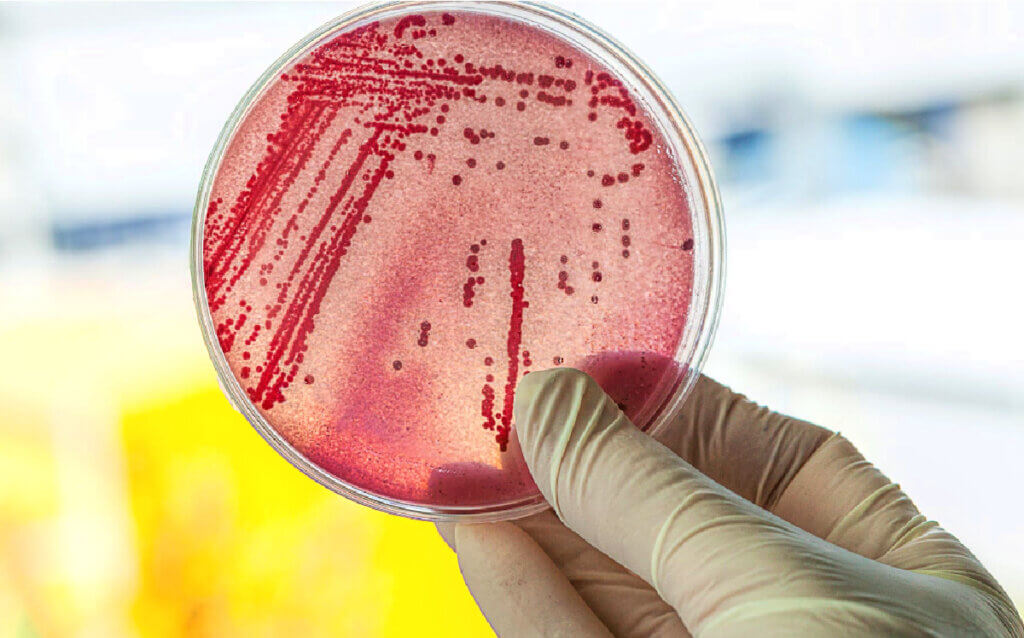
Fraser Valley Water Testing Labs
To ensure drinking water safety from rural Fraser Valley Water Wells, testing for specific bacteria provides critical information about water quality and potential contamination. Water testing for bacteria in well water should only be conducted by accredited laboratories offering drinking water analysis services in the Fraser Valley and all other areas of British Columbia.
Total Coliforms and E. Coli
Total coliform bacteria in well water serve as primary indicators for monitoring the sanitary water quality. Their presence may indicate a compromised water system and the potential for harmful microbes to be present. Special attention is given to Escherichia coli (E. coli), as this bacterium is a more direct sign of recent fecal pollution, indicating a high risk of waterborne pathogens.
Fecal Indicator Bacteria
These bacteria, which include E. coli and other species, are essential in identifying fecal pollution levels in water. They are preferred indicators because they are usually present in greater numbers than the pathogens they signify. They are simpler and more cost-effective to detect.
Pathogenic Microorganisms
The discovery of pathogenic bacteria, viruses, and protozoa in water can be the precursor to various health conditions, particularly in susceptible populations. Indicators such as fecal coliform bacteria in well water indicate the possible presence of pathogens that cause different diseases, from mild stomach discomfort to severe infections.
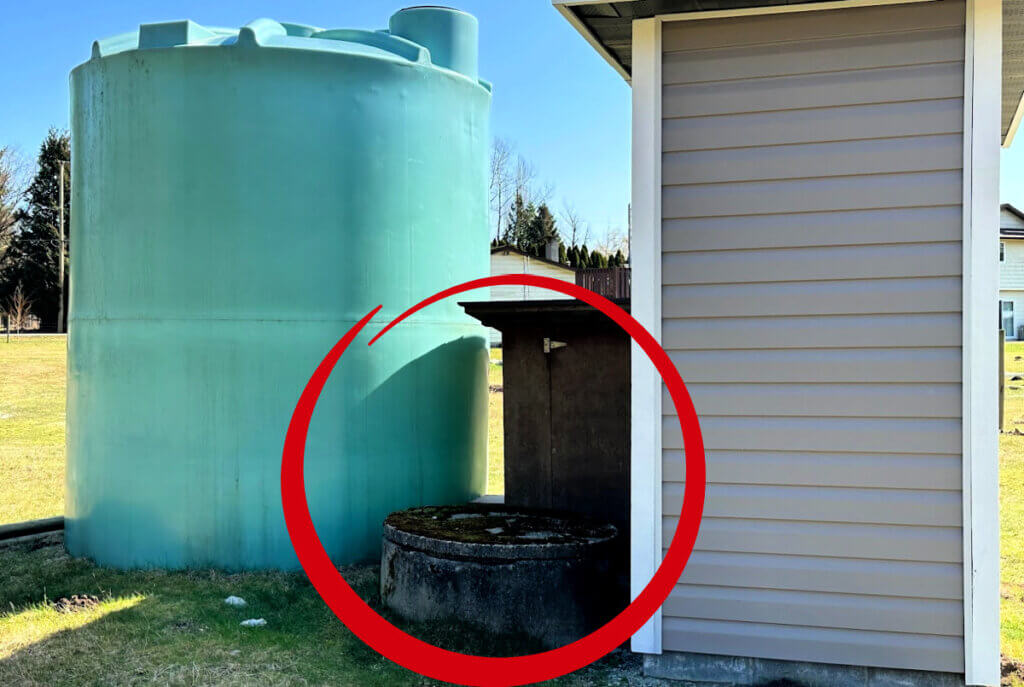
Why Water Wells Be Tested in the Fraser Valley
Regularly well water testing for bacteria such as total coliforms is a preventive measure for private well owners in the Fraser Valley. Water testing is an important tool that helps identify contamination quickly, allowing quick interventions to prevent illnesses and safeguard well water quality. Many water well systems have never been tested for contamination, it’s important to test well water for bacteria at least once a year regardless of the depth of the well.
Fraser Valley Water Testing Lab offers local water testing and lab services for rural property owners with private water systems. The service area includes a wide range of locations, such as Abbotsford, Chilliwack, Yarrow, Langley, Mission, and Maple Ridge and all other areas of the BC Lower Mainland.Water Testing Near Me in the Fraser Valley
Are Deep Drilled Wells Safe from Contamination
The assumption that rural property owners in the Fraser Valley believe that their drilled well water supply is safe because it’s deep is not uncommon, but it is not always true. While deep wells generally have some additional protection from certain kinds of pollution, that protection doesn’t make them immune to all potential contaminants, and the only way to know for sure if well water is safe is to have it tested on a regular basis.
It’s recommended that all private water wells in the Fraser Valley be tested at least once a year, and more frequently for shallow wells and for sources that come from surface areas, such as springs.
- The Groundwater Foundation say testing is the only way to assure a water well has no existing problems, that the water is suitable for its intended use, to track changes in water quality over time, and to determine a treatment system’s effectiveness.
- While it’s true that deep wells have some built-in protection from some types of pollution, they are definitely not immune to all contaminants so they need to be tested on a regular basis . Our message is that property owners in the Fraser Valley should have their well water tested on a regular basis because you never really know if it’s safe until it’s been tested.
Water from a deep drilled well is not automatically safe and the only way to be sure of its safety is to have it tested on a regular basis. Regular water testing is essential to the safety and quality of well water, no matter how deep the well may be.

How Often Should We Test for Bacteria in Well Water in the Fraser Valley?
Property owners with private wells in the Fraser Valley are recommended to test their well water for bacteria at least once a year for total coliforms and E. coli. It may be important to conduct more frequent tests following wildfires, floods, or if there are indications of changes in the well water quality.
Responding to Positive Test Results
Should a water testing report reveal the presence of indicator organisms such as staphylococci, Escherichia coli, fecal coliforms, enterococci (fecal streptococci, group D streptococci), and Pseudomonas aeruginosa, it is imperative to determine and resolve the contamination’s source.
Water treatment and disinfection methods can range from simple chlorination to more sophisticated solutions like ultraviolet (UV) treatment, ozone or submicron filtration systems, depending on the severity and type of water contamination.
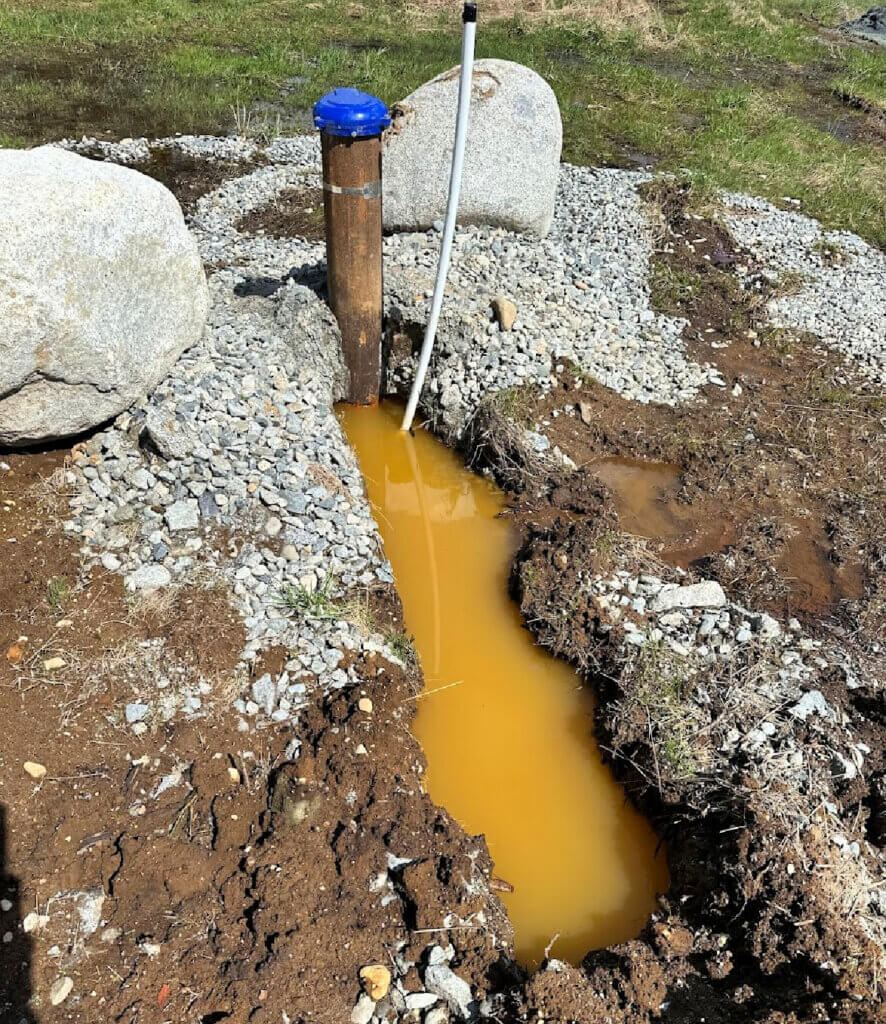
Identifying the Source of Bacterial Contamination.
To safeguard water quality, identify and prevent bacterial contamination sources.
Animal Sources and Septic Systems
Animal Waste: The proximity of water wells near animal areas can introduce harmful bacteria, such as E. coli, from animal waste into the groundwater.
Septic Systems: Inadequate septic system maintenance or failures can cause bacteria to seep into groundwater, potentially affecting water wells located in the Fraser Valley.
Runoff and Improper Well Construction in the Fraser Valley
Agricultural Runoff: Water movement through fields treated with manure, pesticides, or fertilizers can carry bacteria into the groundwater, posing a risk to well water quality.
Spreading Manure on Frozen Ground: Winter conditions increase the risks of manure runoff and water contamination—especially when snow is covered or frozen.
Urban Runoff: Runoff from urbanized areas can carry pollutants and bacteria, increasing the risk of well water contamination.
Well Construction: Improperly constructed or poorly maintained wells can allow bacteria to enter a drilled well. The risk is also higher during wet weather when subsurface water is abundant.
Natural Soil Organisms
While normally harmless, soil-dwelling bacteria can contaminate well water if they infiltrate through structural weaknesses in the well.
Human Impact on Water Quality
Human activity, including improper waste disposal and extensive land-use changes, can pollute groundwater and water wells.
Best Practices for Contamination Prevention
-
- Regular Testing: Engage in frequent testing to detect bacterial presence early.
-
- Well Construction: Ensure wells are located and constructed to prevent contamination, adhering to the British Columbia Water Sustainability Act (WSA) and the Groundwater Protection Regulation (GWPR).
-
- Maintenance: Establish a routine for inspecting and upkeeping water wells and septic systems to maintain water quality.
Ensure Proper Water Well Construction in the Fraser Valley
The construction and upkeep of water wells in the Fraser Valley require adherence to the specifics of the British Columbia Water Sustainability Act (WSA) and the Groundwater Protection Regulation (GWPR).
Here are the key details regarding water well construction, maintenance, repair strategies, and the importance of record-keeping, all in line with British Columbia guidelines.
Essential Elements of Water Well Construction:
Steel casing is used in water well drilling for several important reasons:
- Strength and Durability: Steel is a strong material that can withstand the mechanical stresses of drilling and the pressure from surrounding rock and soil layers. Its durability ensures the well maintains its structural integrity over time.
- Corrosion Resistance: Corrosion-resistant steel casing is crucial for preventing water supply contamination from corroded materials.
- Preventing Contamination: The steel casing is a barrier between the well water and the surrounding environment. Preventing contamination from entering the well through the surface or subsurface.
- Support for the Well Structure: The casing supports the well walls, preventing them from collapsing, especially in loose or unstable geological formations.
- Ease of Installation: Steel casings can be efficiently installed and compatible with various drilling techniques, making them a practical choice for different terrains and geological conditions.
- Longevity: Steel casings have a long lifespan, which is economically beneficial as it reduces the need for frequent replacements or repairs.
- Regulatory Compliance: In many regions of Canada, including British Columbia, the use of steel casing for water well construction is a requirement.
Steel casing is mostly used for water well construction in British Columbia because it is strong, durable, and safeguards water quality and structural integrity.
Vermin-Proof Well Cap: A vermin-proof well cap is a specialized cap designed to securely seal the top of a water well, blocking the entry of rodents, insects, and other small animals.
Well caps are made from durable materials like cast iron, aluminum, and PVC; well caps include a screened vent for air circulation while maintaining a tight seal to prevent contamination.
Water well caps protect well water quality and ensure compliance with health and safety standards, especially with tamper-resistant designs for added security.
Grouting: Properly executed grouting around the casing is a must to block potentially contaminated surface water from entering the well and aquifer.
Depth and Location: Determining the depth and location of a water well is a critical decision based on local geology in British Columbia and proximity to potential contamination sources like septic tanks or industrial zones.
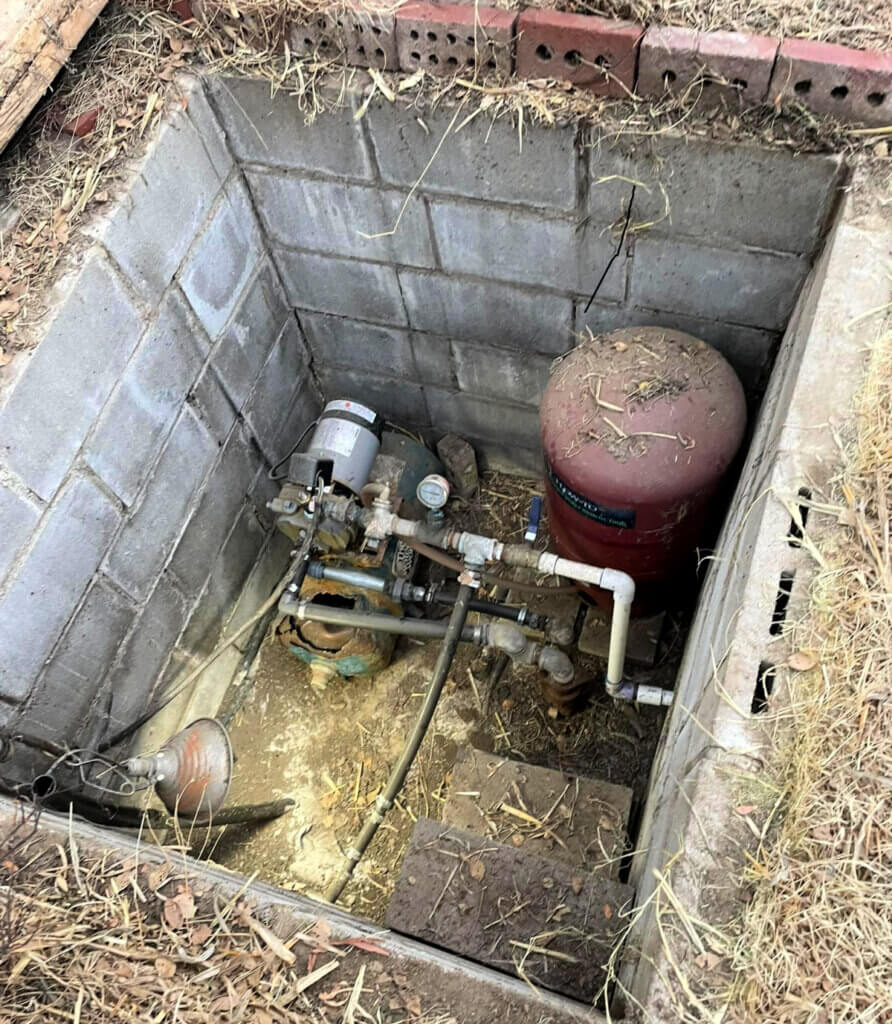
Maintain Your Fraser Valley Water Well Regularly
Regular Inspection: Consistent visual check-ups of the wellhead, casing, and cap can spot issues early on.
Cleanliness: The area surrounding the water well should be kept free from debris and potential pollutants to safeguard the water quality.
Water Testing: Annual water tests in British Columbia for bacteria, nitrates, and specific regional contaminants are crucial to verifying water safety.
Professional Maintenance: Engaging a British Columbia water well contractor for regular inspections and any needed service can prevent small issues from becoming larger problems.
Fraser Valley Specific Water Well Considerations
Awareness of water well construction and maintenance regulations is crucial for rural property owners.
Environmental Factors and Wellhead Protection
In the Lower Mainland, where heavy rainfall is common, wellhead protection must include additional drainage and flood defenses at well sites.
Wellhead protection is necessary to prevent runoff and potential flooding from introducing contaminants into the well water. Implementing effective drainage systems, such as ditches or culverts, helps divert excess water and reduces the risk of surface water contaminating the well.
Additionally, raising the wellhead can protect against direct floodwater intrusion. Regular inspection, maintenance, and water testing are also essential, especially during seasons with heavy rainfall. These measures are key in safeguarding well water quality in this region.
Addressing Problems and Water Well Repairs
Prompt Water Well Repairs: A British Columbia water well professional should immediately assess and remedy suspected contamination or water well problems.
Sanitization and Structural Repair: Solutions could include well cleaning, rehabilitation, or, if needed, drilling a replacement well.
Importance of Water Well Record-Keeping:
Record-keeping for rural property owners in the Fraser Valley with water wells is important for several key reasons:
- Ensuring Water Safety and Quality: Keeping detailed records of water quality tests, maintenance, and any treatments or modifications to the well helps monitor the water’s safety and potability.
This is crucial for protecting the health of those using the well water, as it allows for the early detection and remediation of potential contamination issues. - Compliance with BC Guidelines: Although private wells in British Columbia may not be subject to the same stringent regulations as public water systems, maintaining records demonstrates a commitment to best practices recommended by health and environmental authorities.
- Facilitating Maintenance and Repairs: Accurate and up-to-date records provide valuable information for routine maintenance and necessary repairs. They help track the water well’s performance and identify recurring issues or potential problems, enabling timely and effective solutions.
- Real Estate Transactions: When buying or selling rural land in the Fraser Valley that includes a private water well, having a detailed history of the well can be a valuable asset!
Accurate water well records offer transparency and assurance to potential buyers regarding the well’s maintenance and condition, potentially impacting the property’s value and marketability. - Historical Reference: Good record-keeping is a historical reference for the well. It offers valuable insights into its long-term performance and changes over time. Water well records can be especially helpful when a Fraser Valley property changes hands or if there are changes in local environmental conditions that could affect the well.
It’s difficult to claim that your water has been affected without proof. Test your water annually and hold on to the analytical reports, as this will provide a track record of water quality.
I have witnessed such concerns firsthand while working on the Trans Mountain pipeline. We will generally be looking for paperwork and reports to back up claims.
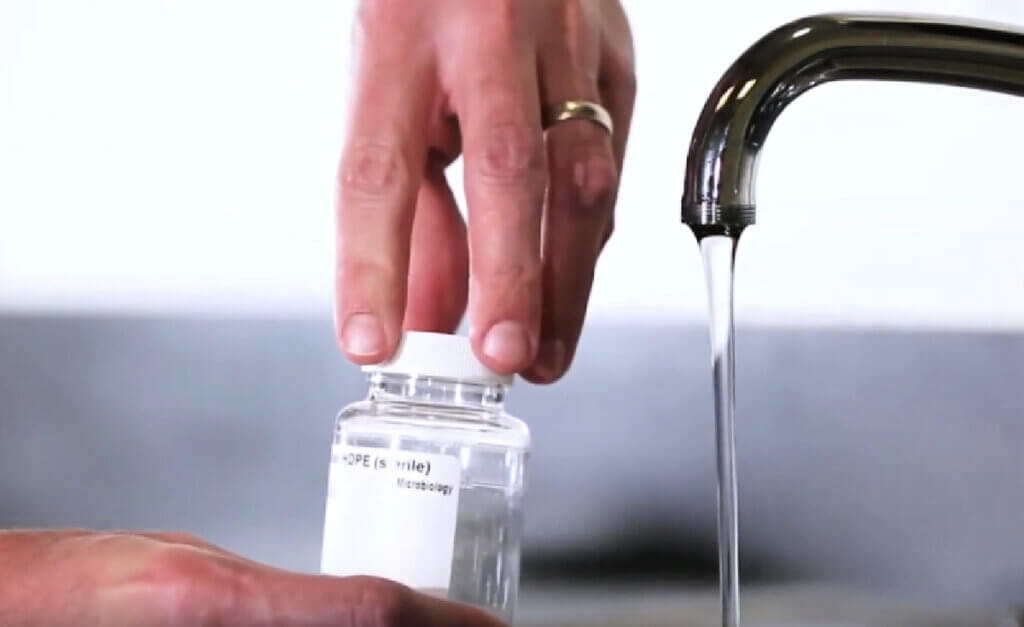
Drinking Water Guidelines for Water Wells
Ensuring the quality and safety of drinking water from private water wells in the Fraser Valley requires an understanding of provincial and national guidelines. These regulations are integral to confirming the water’s suitability for consumption.
Canada Drinking Water Guidelines:
The Maximum Acceptable Concentration (MAC) in the Canadian Drinking Water Guidelines represents the highest level of a substance permissible in drinking water.
MAC values, which Health Canada established, result from in-depth scientific research focusing on the potential health effects of prolonged exposure to various contaminants.
Drinking water values are meticulously calculated to protect all population segments, including vulnerable groups like children, older people, and the immune-compromised, ensuring safety over a lifetime of water consumption.
Canadian Drinking Water Guidelines were primarily developed to ensure the safety and quality of public water systems within the country. The guidelines, established by Health Canada in collaboration with provincial and territorial governments, set the standards for the acceptable levels of various substances in drinking water.
The MAC drinking water guidelines are also a valuable resource for private well owners looking to ensure the quality of their water supply.
Fraser Valley private water well owners who follow the Canadian Drinking Water Guidelines and take appropriate measures to maintain water quality can help protect their health. Regular water testing against these standards, although not mandatory for existing private wells in British Columbia, is highly recommended to ensure water safety.
Fraser Valley Laboratories provide water test kits online, They are designed for easy use and include detailed water sampling instructions, ensuring that individuals can test their water for contaminants and receive a full report on the quality of their water.Water Testing Near Me in the Fraser Valley
6 Reasons to Use Certified Water Testing Labs in the Fraser Valley
Using a British Columbia-accredited water testing laboratory for testing your Fraser Valley well water is crucial for several reasons, particularly when compared to relying on a water treatment company.
- Accuracy and Reliability: Certified laboratories have advanced and calibrated instruments, ensuring accurate and reliable test results. They adhere to strict quality control standards and are accredited by relevant regulatory bodies, guaranteeing that their testing procedures meet industry and governmental standards.
- Unbiased Results: Unlike water treatment companies, which might have a vested interest in the outcome of the tests (as it could lead to the sale of their products or services), certified laboratories provide unbiased results. This impartiality is essential for people to make informed decisions about their water quality without conflict of interest.
- Comprehensive Testing: Certified laboratories offer a wide range of water tests to identify various contaminants, including bacteria, chemicals, heavy metals, and minerals. This comprehensive approach is crucial for a thorough assessment of water quality.
- Health and Safety Compliance: Certified laboratories ensure their testing methods and reporting comply with health and safety standards. They are vital for protecting the health of those consuming the water, as they can detect harmful contaminants at levels that are considered unsafe for human consumption.
- Professional Interpretation: Certified laboratories provide accurate test results and offer professional interpretation. They can advise on the potential health risks associated with certain levels of contaminants and recommend further action if necessary.
- Legal and Regulatory Compliance: Often, using a certified laboratory for water testing may be a legal requirement, especially for real estate sales or mortgages. Even for private wells, having an accredited lab test the water can be crucial for compliance with local health regulations or other legal purposes.
In summary, while Fraser Valley water treatment companies can provide valuable services, relying on a certified water testing laboratory for assessing well water ensures accuracy, impartiality, and compliance with health and safety standards, which are critical for safe water consumption.
Regular water testing should focus on key contaminants such as bacteria, nitrates, arsenic, and other substances that may be of concern locally.
A proactive approach can help ensure the safety and quality of water from private wells. Always keep annual water testing reports available to compare water quality from year to year.
When a Water Analysis Report Does Not Meet Guidelines:
If a water test shows that your well water isn’t meeting quality standards, it’s important to act quickly. You might need to treat the water, or you may need to repair your well. Either way, it’s a good idea to talk to water well experts and water treatment professionals who can guide you through the remedial steps.
Water Well Educational and Support Resources:
Various government and environmental organizations offer educational resources and guidelines for testing and maintaining private water wells in the Fraser Valley.
Educational support is part of their commitment to assisting private well owners in ensuring the safety and quality of their water supply.
Educational water well resources in British Columbia typically include information on how to maintain wells, test for contaminants properly, and what steps to take if issues are detected.
This collaborative approach aligns with the broader goal of promoting public health and environmental stewardship by ensuring that private water supplies in the province are safe and well-managed.
Treatment Options for Contamination in Well Water Systems
Various water treatment disinfection methods are available to address bacterial contamination, ranging from boiling water to advanced treatment systems. The following processes aim to eliminate harmful bacteria that can cause health issues.
First Steps in Assessing Water Quality in Private Wells
Fraser Valley water well owners should conduct a thorough water quality test to identify bacterial presences, such as E. coli or coliform bacteria.
Accredited water testing laboratories serving the Lower Mainland can reveal the types and concentrations of bacteria and guide the selection of appropriate treatment options.
Boiling Water is Quick and Good for Emergencies
Boiling is widely recommended and effective for treating contaminated well water, especially in emergencies or when other disinfection methods are unavailable.
Bringing water to a rolling boil for at least one minute is sufficient to kill most types of pathogens, including bacteria, viruses, and protozoans.
Water should be boiled for at least three minutes in areas above 2,000 meters (6,562 feet) due to the decreased boiling point.
Water Disinfection: Chlorination
Adding chlorine to contaminated well water can effectively destroy bacteria. This method involves carefully dosing with an injection pump system and monitoring chlorine levels to ensure disinfection while avoiding an adverse taste or smell.
Ultraviolet (UV) Disinfection: The Modern Method for Safe Water
Ultraviolet (UV) light disinfection is a chemical-free method for purifying water that works by inactivating or killing microorganisms. Here’s a more detailed explanation:
- How it Works: UV disinfection uses UV light, particularly UV-C light, which has a wavelength that is effective at disrupting the DNA and RNA of microorganisms.
This disruption prevents the microorganisms, such as bacteria, viruses, and protozoa, from reproducing and causing infection. - Requirement for Clear Water: UV light must penetrate water to reach microorganisms. The source water needs to be clear for UV disinfection to be effective. Sediments or particulates in the water can shield microorganisms from UV light, reducing the effectiveness of the treatment.
Hard or iron water exceeding the MAC will scale (coat) the quartz sleeve covering the UV lamp, reducing its ability to disinfect water. - Maintenance and UV Bulb Replacement: Regular maintenance is essential for UV light disinfection systems. It’s important to replace the UV bulb annually, as its effectiveness reduces over time.
Even if the bulb continues to emit light, its disinfection capability diminishes, which is why routine replacement is necessary.
Effectiveness: UV disinfection is highly effective against many pathogens, including those resistant to chlorine, such as Cryptosporidium and Giardia. Ultraviolet does not remove chemical contaminants and heavy metals or improve the taste or odor of water.
In summary, UV light disinfection is a powerful, chemical-free method to purify water, particularly effective against various pathogens, as long as the water is clear and the system is well-maintained.
Water Filtration Systems: For Bacteria in Water?
Some filtration systems, like reverse osmosis, reduce bacterial levels and other contaminants. Using activated carbon filters alone is not enough to remove waterborne bacteria. Additional disinfection methods are necessary.
Well Water Disinfection: Ozonation
Ozone gas is nature’s most powerful disinfectant that eliminates bacteria and viruses from well water. Although effective, this method requires specialized equipment and technical knowledge.
Well Water Disinfection: Distillation
Distillation produces highly purified water by boiling and condensing the steam, removing bacteria and other impurities. It is a rigorous but energy-intensive process.
Maintenance and Regular Water Well Monitoring:
Regular maintenance of treatment systems and water testing is necessary to ensure they operate effectively and provide safe, bacteria-free water.
Considerations for Water Treatment System Selection
Factors influencing treatment choice include contamination levels, water volume, cost, and maintenance. Selecting the appropriate system ensures efficient and economical water purification.
Legal Obligations for Private Well Owners
Property owners, including landlords and tenants, are responsible for ensuring water quality when managing or supplying water from private Fraser Valley water wells. This section reviews the legal landscape in British Columbia and outlines recommended practices for safeguarding water quality.
The Absence of Legal Requirements for Private Wells
While public water systems are subject to government regulations in British Columbia, most private wells do not fall under such strict oversight. The province lacks specific legal requirements for private water well maintenance and water quality monitoring, leaving the onus on the property owner to ensure a safe water supply.
The Importance of Adhering to Public Drinking Water Standards
Private well owners should follow public drinking water standards without legal obligations. Regular testing for contaminants like E. coli and total coliform bacteria is crucial, as their presence may indicate fecal contamination and a risk to human health. Private water well owners can find testing protocols in documents such as Health Canada’s.
Purchasing Real Estate with a Water Well in the Fraser Valley
Due diligence is important when purchasing property with a private well in British Columbia. Potential buyers should obtain a thorough water well inspection that includes the complete system and review any records detailing the well’s history, maintenance, and water quality test results.
Best Practices for Well Maintenance in the Fraser Valley:
Owners should maintain their wells to prevent contamination. Best practices include:
-
- Regular inspection.
-
- Proper sealing of the with a water well cap.
-
- Ensuring the well is safe from potential pollutants.
Guidelines recommend shock chlorination as a method for disinfecting private water wells, as outlined by the Ontario government.
Implications of Non-Compliance:
While direct penalties for non-compliance with voluntary standards are rare, owners may face legal consequences if their neglected water well contaminates neighboring properties or local water sources. In addition, water well maintenance is important for personal safety and the health of those consuming the water.
Bacteria-Related Illness Prevention from Water Wells
Access to clean drinking water is essential for human health, and understanding how to prevent bacteria-related illnesses from water wells is paramount, especially for vulnerable populations. We discuss methods and strategies to ensure water safety and avert potential health risks.
Safe Drinking Water Practices
Ensuring the safety of drinking water from wells begins with regular water quality testing. Health authorities recommend testing well water annually for harmful bacteria, such as E. coli. Homeowners should consult with local health experts to understand regional waterborne pathogens and tailor the testing accordingly.
Boil Water Advisories:
Boil water advisories are critical alerts that one must follow strictly when a water source is suspected to be contaminated. Boiling water for a full minute neutralizes harmful bacteria, making it safe for drinking, cooking, and personal hygiene. Compliance with these advisories is a simple yet effective defense against waterborne diseases.
Impact of Bacteria-Related Illnesses:
Consumption of contaminated water can lead to gastrointestinal upsets to severe ailments like meningitis and respiratory illness. While all individuals can be affected, young children, older people, and those with compromised immune systems face heightened risks. Recognizing symptoms early and seeking medical attention is crucial.
Prevention Strategies for Drinking Water Safety:
A robust safe drinking water prevention plan combines technical, behavioral, and educational approaches.
Effective treatment methods, such as chlorination and ultraviolet purification, can protect well water from bacterial contamination when coupled with consistent maintenance.
Educating the community on emergency preparedness—like storing a safe water supply—further safeguards public health
Impact of Human Activity on Water Microbiology
Human involvement in agriculture, industry, and urban development profoundly influences the microbiological quality of water sources.
Agricultural Runoff and Industrial Waste:
Agricultural runoff introduces excess fertilizers, pesticides, and animal waste into water sources, leading to elevated levels of bacteria and nitrates. Similarly, industrial waste discharges heavy metals and various toxic substances into waterways, affecting the microbial equilibrium and potentially increasing harmful bacteria populations.
Sewage and Fecal Waste Management:
In areas with substandard sewage systems, the risk of overflow introduces pathogenic bacteria into both groundwater and surface waters. The improper disposal of feces, whether from humans or animals, exacerbates fecal contamination, which is a pressing issue, especially near environmental waters.
Effects on Water Microbiology:
Human activity directly impacts changes in bacterial communities within water bodies. The introduction of antibiotics via runoff and sewage contributes to the development of antibiotic-resistant bacteria, presenting an escalating concern for water microbiology.
Risks to Public Health:
Consuming water tainted with microbial contaminants may cause gastrointestinal diseases and more serious health conditions. Individuals with compromised immune systems are especially at risk for severe impacts from such contamination.
Mitigation and Management:
Adopting effective waste management and stringent regulatory measures is crucial for mitigating the influence of human activity on water microbiology. Advanced water treatment technologies and protecting water sources from pollution are integral to ensuring safe water quality.
Challenges of Antibiotic Resistance in Well Water
Water microbiology is currently grappling with significant challenges, particularly in the context of well water, a crucial source for many.
The emergence of antibiotic-resistant pathogens, compounded by the effects of global climate change, underscores the need for diligent monitoring and innovative strategies to maintain water safety.
Rising Threat of Antibiotic Resistance in Well Water Systems
Guaranteeing the quality and safety of drinking water sourced from private wells in the Fraser Valley depends on adhering to both provincial and national guidelines. Understanding these regulations is essential to ensure the water meets drinking standards.
Antibiotic resistance in water systems, including wells, poses a significant public health concern. Well water, often used in rural or semi-urban areas, can become contaminated with antibiotic-resistant bacteria, notably strains of Escherichia coli and Pseudomonas aeruginosa.
These bacteria, which can thrive in anaerobic (oxygen-free) environments typical of some wells, have resisted multiple antibiotics due to their overuse and the improper disposal of pharmaceuticals. This situation may worsen in areas near agricultural or industrial sites where disposal is common.
Bacteria in well water complicate the treatment water that may cause waterborne illnesses, requiring vigilant monitoring and treatment protocols as recommended by water treatment experts in the Fraser Valley.
Climate Change and Its Impact on Well Water Microbiology
Global climate change further compounds these microbial challenges in well water systems. Rising temperatures and altered precipitation patterns can change the microbial ecology of well water, potentially enhancing the growth and spread of pathogens.
Waterborne pathogens like Vibrio cholerae and Salmonella enterica, which thrive in warmer temperatures, pose increased risks.
These pathogens can find their way into well water, particularly if the wells are shallow or inadequately protected. there are many shallow wells in use in the Fraser Valley and many of them have rarely been tested.
Additionally, climate change can affect the abundance of non-pathogenic microorganisms in water, influencing the survival and proliferation of pathogenic species through ecological interactions.
Addressing Water Safety: Vigilant Monitoring and Treatment
In summary, the intersection of antibiotic resistance and climate change impacts presents significant concerns for the safety and quality of well water. This situation necessitates a heightened focus on monitoring, protecting, and treating well water sources.
Understanding how these factors influence the microbial composition of well water is crucial for preventing outbreaks and ensuring the health and safety of those relying on this vital resource.
Frequently Asked Questions: Bacteria in Well Water
This clarifies common concerns about water safety, focusing on bacteria-related questions that individuals frequently have.
What are the health effects of bacteria-contaminated water?
Consuming bacteria-contaminated water can lead to gastrointestinal illnesses, with symptoms ranging from diarrhea and vomiting to more severe conditions, depending on the pathogen involved.
What are the most common types of bacteria found in well water?
Water sources can harbor various bacteria, including coliforms like E. coli, often indicators of fecal contamination, and pathogens like Salmonella and Campylobacter.
What is the deadliest bacteria found in water wells?
Determining the “deadliest” water bacteria in private water wells in British Columbia is not straightforward. The impact of a bacterial contaminant can depend on various factors, including the presence and concentration of the bacteria, the condition of the water well, and the health and immunity of the individuals consuming the water.
However, a few bacterial contaminants are particularly notorious for their potential health impacts:
- E. coli (Escherichia coli): Some strains of E. coli, especially E. coli O157:H7, can cause severe illness, including bloody diarrhea and a potentially fatal kidney condition called hemolytic uremic syndrome. E. coli is a common contaminant in water sources contaminated by fecal matter.
- Legionella pneumophila: This bacterium causes Legionnaires’ disease, a severe form of pneumonia. It can be found in various water systems, including wells, especially when the water is warm and poorly maintained.
- Salmonella: Certain strains of Salmonella can cause serious illness, especially in vulnerable populations like the elderly, young children, and those with weakened immune systems. Like E. coli, it can contaminate wells through fecal matter.
- Campylobacter: This bacterium is one of the most common causes of bacterial diarrhea in the developed world. Private wells are susceptible to campylobacter contamination, particularly those with septic system leaks or agricultural runoff. Thousands of shallow-dug surfaced wells operate in the Fraser Valley, yet many have not been tested.
- Vibrio cholerae: Although less common in places like British Columbia, Vibrio cholerae, the bacterium responsible for cholera, is indeed found in well water under certain conditions.
This bacterium typically thrives in warm, brackish water and can enter well water through various pathways.
The most common route of entry is through contaminated surface water infiltrating shallow or poorly protected wells.
This contamination can occur due to inadequate sanitation, where sewage or runoff containing the bacteria seeps into the groundwater.
The risk of such contamination increases significantly in areas prone to flooding or those with high water tables.
Fraser Valley Laboratories provide water test kits online, They are designed for easy use and include detailed water sampling instructions, ensuring that individuals can test their water for contaminants and receive a full report on the quality of their water.Water Testing Near Me in the Fraser Valley
Beware of FREE Water Testing in the Fraser Valley
Numerous companies in the Fraser Valley have promoted “free” water testing as a tactic to sell their costly water treatment systems. Here’s how it typically unfolds: a salesperson, under the guise of a treatment specialist, visits your home to conduct “tests” using color-changing strips available for $10, offering the same inferior results. However, this comes with the added inconvenience of dealing with a persistent salesperson in your kitchen.
Treat your water samples with caution, as they generally need to be analyzed by a certified laboratory, not by a salesperson at your doorstep offering tests with a kit. Buyer beware…
It’s also important for Fraser Valley well owners to be aware of local Fraser Health advisories and water quality reports, which can provide specific information about regional water safety concerns.
Summary: Article References and Studies
How can the presence of bacteria in tap water be detected?
Standard water tests detect the presence of bacteria in water to assess its quality. These tests check for coliforms and other pathogens to ensure the water is safe for consumption.
Important: If bacteria is present in your water
Bacteria in drinking water indicates contamination from possible sources like septic systems, agricultural runoff, or natural deposits. Such contamination is a serious health hazard. Potentially causing waterborne diseases varying from gastrointestinal problems to more severe illnesses, depending on the bacteria or pathogens involved.
What is the incubation period for illness caused by waterborne bacteria?
The incubation period for waterborne bacterial enteric infections varies depending on the specific bacteria. Studies have reported the following for some waterborne diseases:
-
- Cryptosporidium Infection: During the 1993 Milwaukee outbreak, strong associations between drinking water turbidity and emergency room visits related to gastroenteritis and hospital admissions among the elderly were observed at lags of 5–6 days consistent with the Cryptosporidium incubation period.
A second peak of illness among the elderly occurred at 13 days, accounting for about 40% of all excess cases among the elderly, suggesting a shorter Cryptosporidium incubation period and high risk for person-to-person transmission (Naumova et al., 2003).
- Cryptosporidium Infection: During the 1993 Milwaukee outbreak, strong associations between drinking water turbidity and emergency room visits related to gastroenteritis and hospital admissions among the elderly were observed at lags of 5–6 days consistent with the Cryptosporidium incubation period.
-
- Listeriosis: A brief for the incubation period of listeriosis, an illness that may be waterborne, noted that the incubation period significantly differs by clinical form of the disease. The overall median incubation period was 8 days (range: 1–67 days); longer periods were observed among pregnancy-associated cases (median: 27.5 days; range: 17–67 days) compared with central nervous system cases (median: 9 days; range: 1–14 days) and bacteremia cases (median: 2 days; range: 1–12 days) (Goulet et al., 2013).
-
- E. coli Infection: An outbreak of E. coli O157:H7 associated with a contaminated water supply had a significantly shorter incubation period median than had been previously reported, 3-4 days, potentially due to the high dose of ingested bacteria (Johnsen et al., 2010).
-
- Norwalk-like Virus: Outbreaks of clinically and epidemiologically confirmed Norwalk-like virus infection (acute gastroenteritis) were defined as those in which illness lasted less than 3 days; no fever or signs or symptoms of disease other than diarrhea and vomiting preceded illness; no bacterial pathogen was identified in association with the outbreak; and the pattern of illness was characterized by a mean (or median) incubation of 24-48 hours (Kaplan et al., 1982).
These studies reflect the range among illnesses caused by different waterborne pathogens; their incubation periods may be as short as 24 hours to several weeks.
It is important, therefore, to determine the specific pathogen causing an outbreak so that the risk can be understood and appropriate public health measures can be implemented.
Will bathing in water with coliform bacteria lead to infections?
Engaging in water sports or swimming in areas in the Fraser Valley contaminated with coliform bacteria, such as some strains of E. coli that are antibiotic-resistant, could come with a risk to your well-being.
These bacteria have been found to cause infections, and have been shown to heighten the risk of infection when they’re resistant.
One study, for instance, underscored the danger of having recreational water activities, such as spearfishing, near wastewater treatment plants with antibiotic-resistant E. coli.
This was just one of several to suggest there are potential public health risks to swimming in polluted waters, in addition to a survey called the Beach Bum Survey that noted that surfers were frequently exposed to antibiotic-resistant E. coli.
The global issue of antibiotic-resistant bacteria in bathing waters is a serious one, with implications for anyone who enjoys water-based activities.
These bacteria can be ingested, and may be resistant to critical third-generation cephalosporins, an important tool used to treat a number of infections. These results underscore the critical need for regular water quality testing at recreational sites and the importance of controlling coliform and antibiotic-resistant bacteria.
Bathing waters must be held to the strictest safety standards, in order to ensure that swimmers and anyone taking part in water activities remain safe and healthy.
Latest findings on bacteria levels in private water well systems
Research on bacteria levels in private water well systems, not just specific to the Fraser Valley or British Columbia, emphasizes the necessity of consistent testing and acknowledges the potential for contamination from various sources, such as septic failures and surface water intrusion. Here are some notable insights:
-
- Regular Sampling: Critical for detecting and monitoring Escherichia coli, which shows variation across different geographical locations and seasons.
The detection rate of E. coli increases with more frequent sampling, indicating the need for stricter testing frequency guidelines (Latchmore et al., 2020).
- Regular Sampling: Critical for detecting and monitoring Escherichia coli, which shows variation across different geographical locations and seasons.
-
- Enteric Viruses: Sporadically found in groundwater from private wells in rural areas, albeit infrequently. This finding questions the reliability of using fecal bacteria as indicators for viral contamination (Pang et al., 2021).
-
- Variability in Contamination: Research in Ontario wells reveals differences in fecal sources and pathogen levels, with septic tank density and geological factors offering explanations for regional contamination differences.
A small percentage of samples were contaminated with enteric pathogens, with E. coli qPCR measurements correlating strongly with Bacteroides markers (Felleiter et al., 2020).
- Variability in Contamination: Research in Ontario wells reveals differences in fecal sources and pathogen levels, with septic tank density and geological factors offering explanations for regional contamination differences.
-
- Opportunistic Pathogens: Legionella and mycobacteria were found ubiquitously in private well water, highlighting the potential health risks from inadequately maintained private water systems.
Further investigation is recommended to fully understand these health implications (Xue et al., 2020).
- Opportunistic Pathogens: Legionella and mycobacteria were found ubiquitously in private well water, highlighting the potential health risks from inadequately maintained private water systems.
-
- Shiga Toxin-Producing E. coli (STEC) Risks: The importance of monitoring groundwater sources for STEC presence is underscored to prevent waterborne disease outbreaks (Reynolds et al., 2020).
- Shiga Toxin-Producing E. coli (STEC) Risks: The importance of monitoring groundwater sources for STEC presence is underscored to prevent waterborne disease outbreaks (Reynolds et al., 2020).



